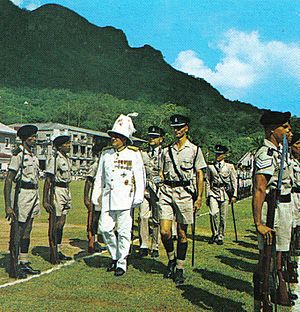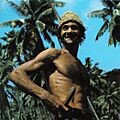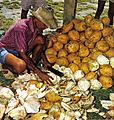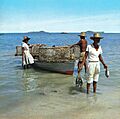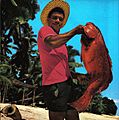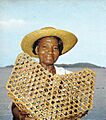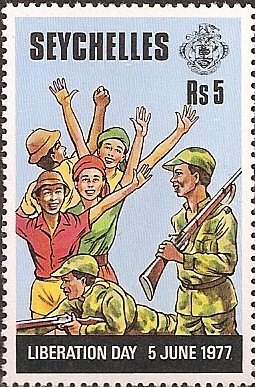History of Seychelles facts for kids

The history of Seychelles began when European explorers first found these islands. However, people from Arab countries and other sailors probably knew about the islands much earlier. On March 15, 1503, a writer named Thomé Lopes saw a tall island, which was likely Silhouette Island. The first time Europeans landed was in January 1609, when sailors from the English East India Company ship Ascension arrived.
France officially claimed the islands in 1756. But no one lived there until the first settlers arrived on the ship Thélemaque on August 27, 1770. Captain Leblanc Lecore brought the first colonists: 15 white men, eight Africans, and five Indians. The Seychellois Creole language grew from these different groups needing to talk to each other.
Later, on May 16, 1794, a British ship called Orpheus, led by Captain Henry Newcome, came to Mahé. The islands soon gave up to Britain. After Britain took over Mauritius, Captain Phillip Beaver arrived in Seychelles on April 23, 1811. He officially made Seychelles a permanent British colony.
Seychelles became an independent country in 1976. After a sudden change in government (a coup d'état), the country was ruled by a single political party from 1977 to 1993. Even after democratic elections started again, leaders from the same party continued to win.
Contents
Early History of Seychelles
The very early history of the Seychelles islands, before Europeans arrived, is not well known. Some people think that Austronesian peoples from Borneo, who later settled on Madagascar, might have stopped here around 200-300 AD. Arab sailors, who traveled across the Indian Ocean for trade, probably knew about the islands too, but they did not settle there.
Arabs were trading special nuts called coco de mer long before Europeans discovered the islands. These nuts are only found in Seychelles and were very valuable. Old, rotted nuts could float and were found on beaches in the Maldives and Indonesia.
European Discovery and Settlement
On March 15, 1503, Vasco da Gama, a famous explorer, saw what was likely Silhouette Island while sailing from India to East Africa. The next day, he saw Desroches Island. These islands, made of granite, started to appear on Portuguese maps as the "Seven Sisters."
In March 1608, an English trading fleet was sailing to India. One ship, the Ascension, got lost in a storm. On January 19, 1609, its crew saw "high land" and sailed towards it. They found an island that was not inhabited, with plenty of fresh water, fish, coconuts, birds, and giant tortoises. They refilled their supplies there. The Ascension left and reported what they found, but Britain did not do anything about it.
Later, in the late 1600s, pirates came to the Indian Ocean from the Caribbean. They set up a base in Madagascar and attacked ships sailing near the Red Sea and the Persian Gulf.
France had taken over the Isle de France (now Mauritius) in 1715. This colony became more important, and in 1735, a strong leader named Bertrand-François Mahé de La Bourdonnais was put in charge. His job was to protect France's sea route to India. In 1742, he sent an expedition led by Lazare Picault to map the islands northeast of Madagascar.
On November 21, 1742, two French ships anchored near Mahé. They found a land with lots of food and resources. Picault named the island Ile d'Abondance, meaning "Island of Plenty." Because his first map was not very good, he was sent back in 1744. He renamed the main island Mahé (after his boss) and the group of islands the Iles de la Bourdonnais. But after La Bourdonnais was replaced in 1746, the islands were forgotten again.
French Control of Seychelles
Quick facts for kids
Isle of Seychelles
|
|||||||||
|---|---|---|---|---|---|---|---|---|---|
| 1770–1810 | |||||||||
| Capital | L'Etablissment | ||||||||
| Commandant | |||||||||
|
• 1793–1810
|
Jean-Baptiste Qeau de Quincy | ||||||||
| ISO 3166 code | SC | ||||||||
|
|||||||||
In 1754, the Seven Years' War started between England and France. This made the leaders in Mauritius remember the islands. Two ships were sent to claim them, led by Corneille Nicholas Morphey. He renamed the largest island Isle de Séchelles, honoring Viscount Jean Moreau de Séchelles, who was France's Minister of Finance. This name later became "Seychelles" in English and was used for the whole group of islands. Mahé was again used for the largest granite island. Morphey claimed the islands for the French king on November 1, 1756.
After the Seven Years' War, France lost Canada and its power in India. This caused the French East India Company, which used to control Mauritius, to decline. So, Mauritius and Seychelles came directly under the French king's rule. The new leader of Mauritius, Pierre Poivre, wanted to end the Dutch control of the valuable spice trade. He thought Mahé would be perfect for growing spices.
In 1768, Nicolas Dufresne organized a business trip to collect timber and tortoises from Seychelles. During this trip, France officially claimed all the granite islands on Christmas Day.
In 1769, sailors Rochon and Grenier showed that a faster route to India could be taken through Seychelles. This made people realize how important the islands' location was. Meanwhile, Poivre finally got seedlings of nutmeg and clove, and 10,000 nutmeg seeds. His attempts to grow them in Mauritius and Bourbon (now Réunion) didn't work well, so he thought of Seychelles again. It was lucky when Brayer du Barré arrived in Mauritius with royal permission to start a settlement on St Anne at his own cost.
On August 12, 1770, 15 white colonists, seven slaves, five Indians, and one black woman settled on St Anne. Du Barré stayed in Mauritius to find more money. After hearing about early success, he asked the government for more funds. However, reports came that ship captains could not get fresh food from the islands. Du Barré's requests for help were ignored. In despair, he went to Seychelles to try and fix things, but it was too late. He became ruined, left for India, and died soon after.
French colonists then brought many Creole slaves from Mauritius to Seychelles. These slaves became the ancestors of the people living there today.
In 1771, Poivre sent Antoine Gillot to Seychelles to create a spice garden. By August 1772, Du Barré's people had left St Anne and moved to Mahé or gone home. Gillot continued to work at Anse Royale, planting nutmeg, cloves, cinnamon, and pepper.
When British ships were seen near Seychelles, the French leaders sent a military group led by Lieutenant de Romainville. They built Etablissement du Roi (Royal Settlement) where modern Victoria is today. Gillot was in charge of the civilian colonists but didn't have real power over them. Mauritius sent a stronger leader, Jean Baptiste Philogene de Malavois, who took command in 1788. He made 30 rules to protect the timber and tortoises. From then on, only good farming methods and careful use of resources were allowed.
On May 16, 1794, the British ship Orpheus, commanded by Captain Henry Newcome, arrived at Mahé with other ships. An officer went ashore to ask for supplies and water. Quinssy, the French leader, suggested that since they couldn't fight the enemy, the colony should surrender. Terms for giving up were written, and the next day, Seychelles was given to Britain. The British ship Centurion returned to Seychelles four years later in September 1798 and renewed the agreement.
The Quincy Era and British Takeover
In 1790, because of the French Revolution, the settlers formed a Colonial Assembly. They decided to run their colony themselves, following their own rules. Land in Seychelles would only go to the children of current colonists. They also wanted to sell their goods as they chose, not as Mauritius told them. They believed that ending slavery was impossible because they thought the colony could not survive without free labor.
Jean-Baptiste Queau de Quincy (1748–1827) took charge of the colony in 1794. He was a clever man who used his skills to guide Seychelles through the wars ahead. Seychelles became a safe place for French corsairs (pirates who had permission to attack enemy ships). Quincy hoped this would go unnoticed. But in 1794, three British ships arrived. Quincy suggested that since they couldn't fight, the colony should surrender. Terms were agreed, and the next day, Seychelles was given to Britain.
The British did not try to fully take over Seychelles at first; they thought it would waste resources. The settlers decided that if they weren't sent soldiers, they couldn't be expected to defend the French flag. So, they would stay neutral and supply anyone who came. This plan worked. The colony grew. Quincy's good surrender terms were renewed seven times when British ships visited.
On July 11, 1801, a French ship arrived with French prisoners sent away by Napoleon. Then a British ship, HMS Sybille, appeared. Quincy had to try to defend the French ship, but after a short fight, the French ship was captured. The British captain wanted to know why Quincy had interfered, breaking his surrender terms. Quincy managed to talk his way out of trouble. He even convinced the British captain to let Seychelles' ships fly a flag saying "Seychelles Capitulation." This allowed them to pass through the British blockade of Mauritius without being bothered.
On September 15, 1801, a famous sea battle happened near the settlement. The British ship Victor was badly damaged, but it managed to turn its side to the French ship La Flêche and fire at it constantly. La Flêche started to sink. Instead of giving up, its captain ran it aground and set it on fire before leaving the ship. The two commanders met on shore afterward, and the British captain praised the French captain for his bravery.
The British tightened their blockade on the French colonies in the Indian Ocean. Réunion surrendered, and then Mauritius surrendered in December 1810. In April 1811, Captain Beaver arrived in Seychelles to say that Quincy's special surrender terms would still stand, but Seychelles had to accept the terms of Mauritius's surrender. Beaver left a British soldier, Lieutenant Bartholomew Sullivan, to watch over Seychelles.
British Rule in Seychelles
|
Crown Colony of the Seychelles
|
|||||||||||
|---|---|---|---|---|---|---|---|---|---|---|---|
| 1903–1976 | |||||||||||
|
|
|||||||||||
| Capital | Victoria | ||||||||||
| Monarch | |||||||||||
|
• 1903–1910
|
King Edward VII | ||||||||||
|
• 1952–1976
|
Queen Elizabeth II | ||||||||||
| Governor | |||||||||||
|
• 1903–1904
|
Ernest Bickham Sweet-Escott | ||||||||||
|
• 1974–1976
|
Colin Hamilton Allan | ||||||||||
| ISO 3166 code | SC | ||||||||||
|
|||||||||||
Lieutenant Sullivan, the first British official, could do little alone to stop settlers from supplying French ships and slave traders. Owning slaves was not against British law then, but trading slaves was illegal. Sullivan tried to stop the colonists who supported slavery. Once, he got a tip and went to Praslin, where he was able to take a shipment of newly arrived slaves. But this was a small win among many problems. Sullivan complained that the Seychellois had "no sense of honor, shame or honesty," and he quit.
The first civilian leader under British rule was Edward Madge. He had many disagreements with Quincy, who remained in the government as a local judge. In the years that followed, the islands became a quiet, less important place. Seychellois landowners had a pleasant life, but it was not always easy to make money because the markets for their crops changed often. The British allowed all French customs to stay. The leader might have been British and reported to London, but he governed using French rules. The biggest complaint the colonists had was that the colony depended on Mauritius.
Another concern for the planters was Britain's laws against slavery. In 1835, slavery was completely ended. The plantations were already struggling because their soil was worn out from years of farming without adding nutrients back. Some planters took their slaves and left. The freed slaves had no land. Most of them stayed on the estates where they had worked as slaves. The colony then went through a period of slow growth. There were no exports, and no money to build new things.
The situation improved when planters realized they could grow coconuts with less work and more profit than traditional crops like cotton, sugar, rice, and maize. Soon, they also found a source of almost free labor again. The British were serious about stopping slavery. They patrolled the East African coast, raiding Arab ships that carried slaves to the Middle East. Slaves freed south of the Equator were brought to Seychelles. They were trained to work for plantation owners, working the land for food and wages. Over thirteen years from 1861, about 2,400 men, women, and children were brought to Seychelles.
The town, which had been called Victoria since 1841, began to grow. Records from 1879 show the types of businesses in the town. There was a pharmacist, two auctioneers, five shops, four liquor stores, a notary, a lawyer, a jeweller, and a watchmaker.
A disaster happened on October 12, 1862, when heavy rain and strong winds hit Mahé. A huge slide of mud and rocks fell on the town from the hills. It is thought that over 70 people died.
Becoming a Crown Colony
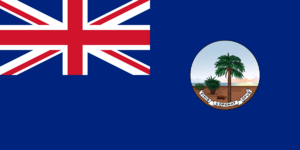
Officials in Seychelles wanted the islands to be a separate, self-governing colony within the British Empire. The leaders in Mauritius, the main colony, supported them. Sir Arthur Gordon, the governor of Mauritius, sent a request to London for them. Some changes were made, but Seychelles did not become a Crown Colony on its own until 1903. That's when its first Governor, Sir Ernest Bickham Sweet-Escott, took office. To show its new status, the colony got a botanical garden and a clock tower in the center of Victoria. However, the French language and culture remained very strong.
The British, like the French before them, saw Seychelles as a good place to send political prisoners who caused trouble. Over the years, Seychelles became home to prisoners from Zanzibar, Egypt, Cyprus, and Palestine, among others. The first exiles were Sultan Abdullah and Lela Pandak Lam from Perak, who arrived in 1875. They were involved in the murder of a British official. Like many exiles who followed, they settled well into life in Seychelles and grew to like the islands. Sultan Abdullah's son even took a popular local French song, "La Rosalie," back home with him. With new words, it later became Negaraku, the national anthem of Malaysia.
Perhaps the most famous political prisoner was Archbishop Makarios from Cyprus, who arrived in 1956. He also loved his "prison." He wrote, "When our ship leaves harbor, we shall take with us many good and kindly memories of the Seychelles...may God bless them all."
World War I caused great hardship in the islands. Ships could not bring in important goods or take away exports. Wages dropped, and prices went up by 150 percent. Many people turned to crime, and prisons became very full. Joining the Seychelles Labour Contingent, a group formed at the request of General Smuts, seemed like a way out. However, it was not easy. The group, 800 strong, was sent to East Africa. After only five months, so many had died from diseases like dysentery, malaria, and beriberi that the group was sent home. In total, 335 men died.
By the end of World War I, the population of Seychelles was 24,000, and they felt ignored by Great Britain. A new group called the Planters Association pushed for more say in how Seychelles was run. After 1929, more money became available through a new law, but it was a time of economic hardship. The price of copra (dried coconut meat) was falling, and so were wages. Workers asked the government to improve their poor working conditions and reduce the tax burden. Governor Sir Arthur Grimble started some changes, like not taxing lower-income groups. He also wanted to create good housing and give small plots of land to those who had none. Many of his changes were not approved until World War II began, and everything was put on hold.
The Planters Association spoke for the white landowners. But until 1937, the workers had no voice. The League of Coloured Peoples was formed to demand a minimum wage, fair pay decisions, and free health care for everyone. During World War II, a seaplane base was set up on St Anne to watch ships in the area. Soldiers were stationed on the islands, and a battery (a group of cannons) was built at Pointe Conan to protect the harbor. About 2,000 Seychellois men served in military groups in Egypt, Palestine, and Italy.
At home, Seychelles had its own problems. The first political party, the Taxpayers Association, was formed in 1939. A British governor described it as "the embodiment of every reactionary force in Seychelles," meaning it only cared about protecting the interests of the plantation owners. After the war, these landowners also gained the right to vote. However, voting was limited to property owners who could read and write, which was only about 2,000 people out of a population of 36,000. In the first elections in 1948, most of those elected to the Legislative Council were, as expected, members of the Planters and Taxpayers Association.
In 1958, France bought back the Glorioso islands from Seychelles.
-
Postage stamp with portrait of Queen Elizabeth II, 1954
Independence for Seychelles
|
First Republic of Seychelles
|
|||||||||
|---|---|---|---|---|---|---|---|---|---|
| 1976–1977 | |||||||||
|
|
|||||||||
|
Motto: "Finis Coronat Opus (The End Crowns the Work)"
|
|||||||||
|
Anthem: En Avant
|
|||||||||
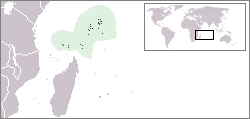 |
|||||||||
| Capital | Victoria | ||||||||
| Government | Unitary Semi-presidential republic | ||||||||
| President | |||||||||
|
• 1976-1977
|
Sir James Mancham | ||||||||
| Prime minister | |||||||||
|
• 1976–1977
|
France-Albert René | ||||||||
| Legislature | National Assembly | ||||||||
| Historical era | Cold War | ||||||||
|
• Independence of Seychelles
|
29 June 1976 | ||||||||
|
• 1977 Seychelles coup d'état
|
4-5 June 1977 | ||||||||
| Currency | Roupie | ||||||||
| ISO 3166 code | SC | ||||||||
|
|||||||||
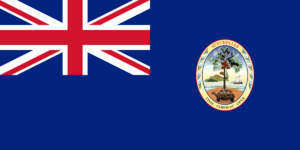
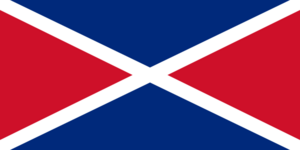
New political groups didn't appear until 1964. That year, the Seychelles People's United Party (SPUP) was formed. Led by France-Albert René, they wanted socialism and independence from Britain. In contrast, James Mancham's Seychelles Democratic Party (SDP), created the same year, represented business people and planters. They wanted Seychelles to stay closer to Britain.
Elections were held in 1966, and the SDP won.
In March 1970, leaders from Seychelles met in London to discuss a new constitution. James Mancham's SDP wanted to stay closely linked with the UK. France-Albert René's SPUP wanted full independence. More elections in November 1970 brought a new constitution, and Mancham became Chief Minister. Further elections in April 1974 saw both main parties campaigning for independence. After these elections, talks with the British led to an agreement. Seychelles became an independent republic within the Commonwealth on June 29, 1976.
In 1970, Seychelles got a new constitution, allowing all adults to vote. It also got a government council with more elected members. Self-government was granted in 1975, and full independence came in 1976. In 1975, a shared government was formed with James R. Mancham as President and France-Albert René as Prime Minister. Sir James Mancham became the country's first President, with René as Prime Minister. These talks also returned the islands of Aldabra, Farquhar, and Des Roches to Seychelles. These islands had been moved from Seychelles in November 1965 to be part of the new British Indian Ocean Territory (BIOT).
One-Party Rule
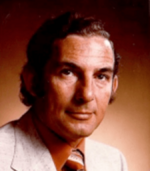
On June 5, 1977, there was a nearly peaceful change in government, called a coup d'état. Mancham was removed from power while he was abroad, and France-Albert René became president. Seychelles became a country ruled by a single political party from 1979 to 1991. The SPUP changed its name to the Seychelles People's Progressive Front (SPPF). René was the only candidate for president in elections in 1979, 1984, and 1989, winning with over 90% of the votes.
In 1981, the country faced an attempt to overthrow the government by Mike Hoare and a group of hired soldiers supported by South Africa. Some people have suggested this was a secret plan to put the former pro-American president back in power.
The government was again threatened by a military uprising in August 1982. But it was stopped after two days when loyal troops, helped by forces from Tanzania and some of the hired soldiers who had escaped from prison, took back the rebel-held places.
Gérard Hoarau, a leader of the opposition group living outside Seychelles, was the head of the Mouvement Pour La Resistance (MPR). He was against René's government and was based in London. He was killed on November 29, 1985, by an unknown gunman outside his London home. Hoarau is buried in London.
The SPPF government made several changes, including making education and healthcare available to everyone. They also made environmental improvements. During this time, Seychelles grew quickly. It became the most developed country in Africa based on the Human Development Index. The lives of Seychellois Creole people, who are the majority of the population, also improved a lot due to government policies aimed at fairness between races. However, the white minority (mostly people of French descent) still held most important government jobs and led the political party.
In February 1992, Conrad Greslé, a local accountant and landowner, who supported having many political parties in Seychelles, was arrested. He was accused of planning to overthrow President René's government with help from foreign hired soldiers. Greslé died in Seychelles in July 1993.
Many Seychellois people were forced to leave their homes or country by the government. The Greslé family was one of the few landowners of French descent who stayed after the 1977 change in government. Most others had their land taken and were forced to leave. Anyone who openly opposed René's government faced threats, intimidation, or exile throughout the 1980s.
Return to Democracy
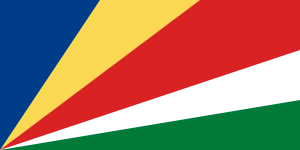
After the dissolution of the Soviet Union, President René announced on December 4, 1991, that Seychelles would return to a system with many political parties. This was after almost 16 years of one-party rule. On December 27, 1991, the Constitution of Seychelles was changed to allow political parties to register. Among those returning to Seychelles was James Mancham, who came back in April 1992 to restart his party, the Democratic Party (DP). By the end of that month, eight political parties had registered to take part in the first step of the change: electing members to a commission that would write a new constitution. This election happened from July 23–26, 1992.
The constitutional commission had 22 elected members, 14 from the SPPF and 8 from the DP. They started work on August 27, 1992. Both President René and Mancham called for the country to come together and agree on a new democratic constitution. A final agreement was reached on May 7, 1993. A vote (referendum) was held from June 15–18 to approve it. The new constitution was approved with 73.9% of voters in favor and 24.1% against.
The first elections for president and lawmakers under the new constitution were held from July 23–26, 1993. President René won a big victory. Three political groups competed: the SPPF, the DP, and the United Opposition (UO), which was a group of three smaller parties. Two other smaller opposition parties joined with the DP. All parties and international observers agreed that the results were "free and fair."
Three candidates ran in the presidential election from March 20–22, 1998: France-Albert René of the SPPF, James Mancham of the DP, and Wavel Ramkalawan. President René and his SPPF won by a large margin. The president's popularity in elections increased to 66.6% in 1998 from 59.5% in 1993. The SPPF also got 61.7% of the votes in the 1998 National Assembly election, up from 56.5% in 1993.
In 1999, Mancham switched to the centrist Seychelles National Party (SNP), which became the main opposition party. It lost to the SPPF in the 2002 parliamentary election with 42% of the vote. In 2004, René handed the presidency to his former vice-president and long-time friend, James Michel. Michel won the 2006 presidential election against SNP leader Ramkalawan with 53.5% of the vote. The former vice-president, Danny Faure, became president on October 16, 2016, after James Michel unexpectedly resigned.
On October 26, 2020, the opposition party took power in Seychelles for the first time since 1977. This happened after their victory in the presidential election. Anglican priest Wavel Ramkalawan defeated President Danny Faure, winning 54.9% of the votes to Faure's 43.5%.
The election for the National Assembly was held from October 22-24, 2020. The Seychelles National Party, the Seychelles Party for Social Justice and Democracy, and the Seychelles United Party formed a group called Linyon Demokratik Seselwa (LDS). LDS won 25 seats, and the former ruling party, United Seychelles (US), won 10 seats out of the 35 seats in the National Assembly.
See also
 In Spanish: Historia de Seychelles para niños
In Spanish: Historia de Seychelles para niños
























